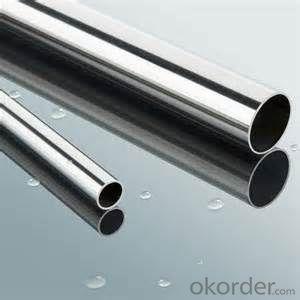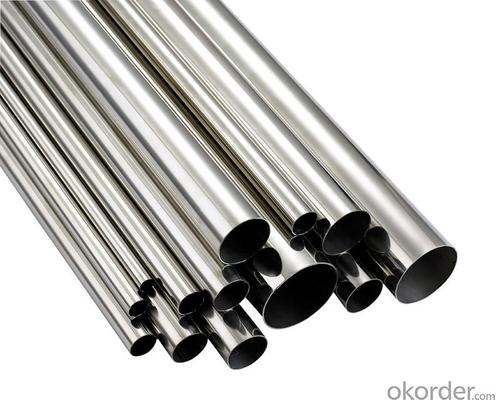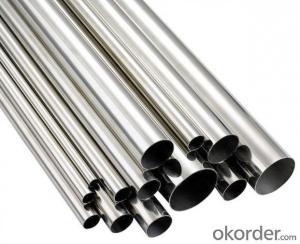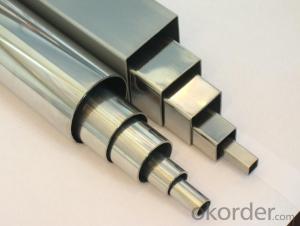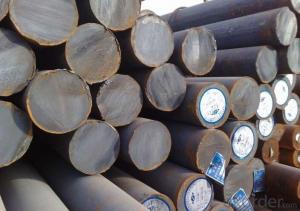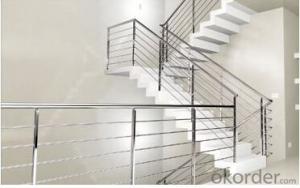STAINLESS STEEL PIPES 410material
- Loading Port:
- China Main Port
- Payment Terms:
- TT OR LC
- Min Order Qty:
- -
- Supply Capability:
- -
OKorder Service Pledge
OKorder Financial Service
You Might Also Like
Description:
Stainless Steel Pipe
Material:
304 321 316 310
Packing:
In bundle
MOQ:
5 TONS
Comparison of standardized steels
| EN-standard Steel no. k.h.s DIN | EN-standard Steel name | SAE grade | UNS |
|---|---|---|---|
| 1.4109 | X65CrMo14 | 440A | S44002 |
| 1.4112 | X90CrMoV18 | 440B | S44003 |
| 1.4125 | X105CrMo17 | 440C | S44004 |
| | | 440F | S44020 |
| 1.4016 | X6Cr17 | 430 | S43000 |
| 1.4408 | G-X 6 CrNiMo 18-10 | 316 | |
| 1.4512 | X6CrTi12 | 409 | S40900 |
| | | 410 | S41000 |
| 1.4310 | X10CrNi18-8 | 301 | S30100 |
| 1.4318 | X2CrNiN18-7 | 301LN | |
| 1.4307 | X2CrNi18-9 | 304L | S30403 |
| 1.4306 | X2CrNi19-11 | 304L | S30403 |
| 1.4311 | X2CrNiN18-10 | 304LN | S30453 |
| 1.4301 | X5CrNi18-10 | 304 | S30400 |
| 1.4948 | X6CrNi18-11 | 304H | S30409 |
| 1.4303 | X5CrNi18-12 | 305 | S30500 |
| | X5CrNi30-9 | 312 | |
| 1.4541 | X6CrNiTi18-10 | 321 | S32100 |
| 1.4878 | X12CrNiTi18-9 | 321H | S32109 |
| 1.4404 | X2CrNiMo17-12-2 | 316L | S31603 |
| 1.4401 | X5CrNiMo17-12-2 | 316 | S31600 |
| 1.4406 | X2CrNiMoN17-12-2 | 316LN | S31653 |
| 1.4432 | X2CrNiMo17-12-3 | 316L | S31603 |
| 1.4435 | X2CrNiMo18-14-3 | 316L | S31603 |
| 1.4436 | X3CrNiMo17-13-3 | 316 | S31600 |
| 1.4571 | X6CrNiMoTi17-12-2 | 316Ti | S31635 |
| 1.4429 | X2CrNiMoN17-13-3 | 316LN | S31653 |
| 1.4438 | X2CrNiMo18-15-4 | 317L | S31703 |
| 1.4362 | X2CrNi23-4 | 2304 | S32304 |
| 1.4462 | X2CrNiMoN22-5-3 | 2205 | S31803/S32205 |
| 1.4539 | X1NiCrMoCu25-20-5 | 904L | N08904 |
| 1.4529 | X1NiCrMoCuN25-20-7 | | N08926 |
| 1.4547 | X1CrNiMoCuN20-18-7 | 254SMO | S31254 |
Stainless steel’s resistance to corrosion and staining, low maintenance and familiar lustre make it an ideal material for many applications. There are over 150 grades of stainless steel, of which fifteen are most commonly used. The alloy is milled into coils, sheets, plates, bars, wire, and tubing to be used in cookware, cutlery, household hardware, surgical instruments, major appliances, industrial equipment (for example, in sugar refineries) and as an automotive and aerospace structural alloy and construction material in large buildings. Storage tanks and tankers used to transport orange juice and other food are often made of stainless steel, because of its corrosion resistance. This also influences its use in commercial kitchens and food processing plants, as it can be steam-cleaned and sterilized and does not need paint or other surface finishes.
Stainless steel is used for jewelry and watches with 316L being the type commonly used for such applications. It can be re-finished by any jeweler and will not oxidize or turn black.
Some firearms incorporate stainless steel components as an alternative to blued or parkerized steel. Some handgun models, such as the Smith & Wesson Model 60 and the Colt M1911 pistol, can be made entirely from stainless steel. This gives a high-luster finish similar in appearance to nickel plating. Unlike plating, the finish is not subject to flaking, peeling, wear-off from rubbing (as when repeatedly removed from a holster), or rust when scratched.
Architecture[edit]
Stainless steel is used for buildings for both practical and aesthetic reasons. Stainless steel was in vogue during the art deco period. The most famous example of this is the upper portion of the Chrysler Building (pictured). Some diners and fast-food restaurants use large ornamental panels and stainless fixtures and furniture. Because of the durability of the material, many of these buildings retain their original appearance.
Type 316 stainless is used on the exterior of both the Petronas Twin Towers and the Jin Mao Building, two of the world's tallest skyscrapers.[17]
The Parliament House of Australia in Canberra has a stainless steel flagpole weighing over 220 tonnes (240 short tons).
The aeration building in the Edmonton Composting Facility, the size of 14 hockey rinks, is the largest stainless steel building in North America.
Bridges[edit]
Cala Galdana Bridge in Minorca (Spain) was the first stainless steel road bridge.
Sant Fruitos Pedestrian Bridge (Catalonia, Spain), arch pedestrian bridge.
Padre Arrupe Bridge (Bilbao, Spain) links the Guggenheim museum to the University of Deusto.[18]
Monuments and sculptures[edit]
The Unisphere, constructed as the theme symbol of the 1964-5 World's Fair in New York City, is constructed of Type 304L stainless steel as a sphere with a diameter of 120 feet, or 36.57 meters.
The Gateway Arch (pictured) is clad entirely in stainless steel: 886 tons (804 metric tonnes) of 0.25 in (6.4 mm) plate, #3 finish, type 304 stainless steel.[19]
The United States Air Force Memorial has an austenitic stainless steel structural skin.
The Atomium in Brussels, Belgium was renovated with stainless-steel cladding in a renovation completed in 2006; previously the spheres and tubes of the structure were clad in aluminium.
The Cloud Gate sculpture by Anish Kapoor, in Chicago US.
The Sibelius monument in Helsinki, Finland, is made entirely of stainless steel tubes.
The Man of Steel (sculpture) under construction in Rotherham, England.
Other[edit]
- Automotive bodies
The Allegheny Ludlum Corporation worked with Ford on various concept cars with stainless steel bodies from the 1930s through the 1970s, as demonstrations of the material's potential. The 1957 and 1958 Cadillac Eldorado Brougham had a stainless steel roof. In 1981 and 1982, the DeLorean DMC-12 production automobile used stainless steel body panels over a glass-reinforced plasticmonocoque. Intercity buses made by Motor Coach Industries are partially made of stainless steel. The aft body panel of the Porsche Cayman model (2-door coupe hatchback) is made of stainless steel. It was discovered during early body prototyping that conventional steel could not be formed without cracking (due to the many curves and angles in that automobile). Thus, Porsche was forced to use stainless steel on the Cayman.
- Passenger rail cars
Rail cars have commonly been manufactured using corrugated stainless steel panels (for additional structural strength). This was particularly popular during the 1960s and 1970s, but has since declined. One notable example was the early Pioneer Zephyr. Notable former manufacturers of stainless steel rolling stock included the Budd Company (USA), which has been licensed to Japan's Tokyu Car Corporation, and the Portuguese company Sorefame. Many railcars in the United States are still manufactured with stainless steel, unlike other countries who have shifted away.
- Aircraft
Budd also built an airplane, the Budd BB-1 Pioneer, of stainless steel tube and sheet, which is on display at the Franklin Institute.
The American Fleetwings Sea Birdamphibious aircraft of 1936 was also built using a spot-welded stainless steel hull.
The Bristol Aeroplane Company built the all-stainless steel Bristol 188 high-speed research aircraft, which first flew in 1963.
The use of stainless steel in mainstream aircraft is hindered by its excessive weight compared to other materials, such as aluminum.
- Jewelry
Valadium, a stainless steel and 12% nickel alloy is used to make class and military rings. Valadium is usually silver-toned, but can be electro-charged to give it a gold tone. The gold tone variety is known as Sun-lite Valadium
- Q: What is the difference between hot rolled and cold drawn stainless steel pipes?
- The production of hot rolled stainless steel pipes involves heating a solid steel billet or ingot to a high temperature and then rolling it into the desired shape and size. This process yields a rougher surface finish and a larger grain structure, increasing the pipe's susceptibility to corrosion. Nevertheless, hot rolled pipes are generally more cost-effective and convenient for large-scale production. In contrast, cold drawn stainless steel pipes are crafted by pulling a solid steel billet or bar through a die at room temperature. This method results in a smoother surface finish and a smaller grain structure, enhancing the pipe's ability to resist corrosion. Cold drawn pipes are typically pricier and require more time and effort to manufacture, but they offer superior quality and performance for various applications. To summarize, the primary distinction between hot rolled and cold drawn stainless steel pipes lies in the manufacturing process and the resulting surface finish and grain structure. Hot rolled pipes are less expensive and easier to produce but may be more vulnerable to corrosion, whereas cold drawn pipes are more costly and time-consuming to manufacture but provide better corrosion resistance and overall quality.
- Q: Can stainless steel pipes be used for cryogenic applications?
- Yes, stainless steel pipes can be used for cryogenic applications. Stainless steel is known for its excellent low-temperature properties, including good strength, ductility, and resistance to corrosion. These properties make stainless steel pipes suitable for transporting and storing cryogenic fluids such as liquid nitrogen, oxygen, or argon. The high strength-to-weight ratio of stainless steel allows for the construction of lightweight and durable cryogenic systems. Additionally, stainless steel pipes can withstand the extreme temperature gradients and thermal stresses commonly encountered in cryogenic applications. However, it is important to choose the appropriate grade of stainless steel that is specifically designed for cryogenic service to ensure optimal performance and safety.
- Q: What are the different types of stainless steel pipes available?
- There are several different types of stainless steel pipes available, each with their own unique properties and uses. 1. Austenitic stainless steel pipes: This type of stainless steel is the most common and versatile. It contains high levels of chromium and nickel, making it highly resistant to corrosion and oxidation. Austenitic stainless steel pipes are widely used in various industries, including construction, automotive, and food processing. 2. Ferritic stainless steel pipes: Ferritic stainless steel contains high levels of chromium but low levels of carbon, which gives it excellent resistance to corrosion. These pipes are commonly used in applications where high strength and resistance to stress corrosion cracking are required. 3. Martensitic stainless steel pipes: Martensitic stainless steel is known for its high strength and hardness. These pipes are often used in applications that require resistance to wear and abrasion, such as cutlery, tools, and bearings. 4. Duplex stainless steel pipes: Duplex stainless steel is a combination of austenitic and ferritic stainless steels. This type of steel offers excellent corrosion resistance and high strength. Duplex stainless steel pipes are commonly used in industries that require resistance to chloride stress corrosion cracking, such as offshore oil and gas production. 5. Precipitation-hardening stainless steel pipes: Precipitation-hardening stainless steel pipes are heat-treatable and have high strength and corrosion resistance. They are often used in industries such as aerospace and chemical processing, where both strength and resistance to corrosion are essential. These are just a few examples of the different types of stainless steel pipes available. The choice of the right type of stainless steel pipe depends on the specific application and the required properties, such as corrosion resistance, strength, and temperature resistance.
- Q: What is the difference between Type 304L and Type 316L stainless steel pipes?
- Type 304L and Type 316L stainless steel pipes are both popular choices for various applications due to their corrosion-resistant properties. However, they differ in their composition and performance in specific environments. The main difference lies in their alloy content. Type 304L stainless steel contains 18-20% chromium and 8-12% nickel, while Type 316L stainless steel contains 16-18% chromium, 10-14% nickel, and 2-3% molybdenum. The addition of molybdenum in Type 316L enhances its resistance to corrosion, particularly in chloride-rich environments. This makes Type 316L more suitable for applications where the pipes will be exposed to seawater, brine, or other aggressive chemicals. Another distinguishing factor is their mechanical properties. Type 316L stainless steel has slightly higher tensile strength and yield strength compared to Type 304L. It also exhibits better creep and stress rupture properties, making it more suitable for high-temperature applications. However, Type 304L is still a good choice for most general-purpose applications and offers excellent durability and longevity. In terms of cost, Type 316L stainless steel pipes are generally more expensive than Type 304L due to the added alloying elements. Therefore, the choice between the two will depend on the specific requirements of the application, considering factors such as the corrosive environment, temperature, and budget. Overall, while both Type 304L and Type 316L stainless steel pipes offer excellent corrosion resistance, Type 316L provides superior performance in more aggressive environments and higher temperatures. It is important to consult with a materials expert or engineer to determine the most suitable stainless steel pipe for a specific application.
- Q: Can stainless steel pipes be used in the oil and gas industry?
- Yes, stainless steel pipes can be used in the oil and gas industry. Stainless steel pipes offer several advantages that make them suitable for use in this industry. Firstly, stainless steel has high corrosion resistance, which is crucial for withstanding the harsh environments and corrosive substances present in the oil and gas industry. This resistance to corrosion helps to prevent leaks and ensures the integrity of the pipes, promoting safety and reliability. Additionally, stainless steel pipes have excellent strength and durability, allowing them to withstand high pressures and temperatures that are often encountered in oil and gas operations. Moreover, stainless steel is non-reactive, meaning it does not contaminate the oil or gas being transported, ensuring the purity and quality of the product. Overall, the superior properties of stainless steel make it a preferred choice for oil and gas industry applications, providing a reliable and long-lasting solution.
- Q: Are stainless steel pipes suitable for extreme weather conditions?
- Yes, stainless steel pipes are highly suitable for extreme weather conditions. Stainless steel is known for its exceptional corrosion resistance, making it resistant to rust and deterioration caused by harsh weather elements such as rain, snow, and extreme temperatures. It can withstand freezing temperatures, high humidity, and exposure to UV rays without losing its structural integrity. Additionally, stainless steel pipes are also highly durable and have a long lifespan, making them an excellent choice for withstanding extreme weather conditions.
- Q: Can stainless steel pipes be galvanized?
- Indeed, it is possible to galvanize stainless steel pipes. Galvanization refers to the application of a safeguarding zinc coating on steel or iron to thwart the occurrence of rust. Although stainless steel already possesses a high level of resistance to corrosion, galvanization can serve as an extra layer of defense in specific situations. However, it is worth mentioning that galvanizing stainless steel pipes is not as prevalent as galvanizing carbon steel pipes since the innate corrosion resistance of stainless steel is generally satisfactory for most applications. Moreover, the process of galvanizing stainless steel can modify its visual appearance and may not be suitable for certain aesthetic prerequisites.
- Q: How do stainless steel pipes compare to fiberglass pipes?
- Distinct characteristics and advantages set stainless steel pipes and fiberglass pipes apart. When comparing the two, one must consider factors such as strength, durability, corrosion resistance, cost, and ease of installation. In terms of strength, stainless steel pipes have a clear advantage, known for their exceptional strength and durability. They can withstand high-pressure applications and heavy loads. On the other hand, fiberglass pipes are relatively weaker and may not be suitable for high-strength and resistance applications. Durability is another crucial aspect. Stainless steel pipes are highly durable, enduring extreme temperatures, chemicals, and physical stress without deteriorating. Fiberglass pipes, though durable, are more susceptible to damage from impact, extreme temperatures, and UV radiation. Therefore, stainless steel pipes are a more reliable choice for long-term use in harsh environments. Corrosion resistance is significant when selecting pipes. Stainless steel pipes are renowned for their excellent corrosion resistance, making them ideal for applications where exposure to corrosive substances is a concern. Fiberglass pipes, while relatively resistant to many chemicals, can be affected by certain corrosive substances and may require additional protective coatings. Cost is an important consideration for any project. Due to the higher cost of raw materials and manufacturing processes, stainless steel pipes tend to be more expensive than fiberglass pipes. Conversely, fiberglass pipes are generally more affordable, making them a cost-effective option for budget-constrained projects. Finally, ease of installation is worth mentioning. The weight and rigidity of stainless steel pipes require specialized tools and expertise for installation. In contrast, fiberglass pipes being lightweight and flexible, are easier to handle and install, reducing labor costs and time. In conclusion, stainless steel pipes offer superior strength, durability, and corrosion resistance compared to fiberglass pipes. However, fiberglass pipes are a more cost-effective option and easier to install. Ultimately, the choice between the two depends on the specific project requirements, considering factors such as application, budget, and environmental conditions.
- Q: Water and electricity thin wall stainless steel tube 304 material delta 2 what does that mean?
- 304 is a stainless steel number, 2.9 refers to the pipe wall thickness.
- Q: What are the dimensions and sizes of stainless steel pipes?
- Stainless steel pipes come in various dimensions and sizes to cater to different industrial and commercial applications. The dimensions and sizes of stainless steel pipes are determined by their nominal diameter (DN) and their schedule or wall thickness. The nominal diameter refers to the approximate internal diameter of the pipe, and it is commonly expressed in inches or millimeters. The most commonly available stainless steel pipe sizes range from 1/8 inch (3.175 mm) up to 48 inches (1219 mm) in nominal diameter. However, larger sizes can be custom-made to meet specific requirements. The schedule or wall thickness of stainless steel pipes is denoted by a schedule number, which indicates the thickness of the pipe's walls. The most common schedules for stainless steel pipes are Sch 5, Sch 10, Sch 40, and Sch 80. The higher the schedule number, the thicker the walls of the pipe. In addition to the dimensions and sizes, stainless steel pipes are also available in various lengths, typically ranging from 20 feet (6.1 meters) to 40 feet (12.2 meters). However, custom lengths can also be ordered based on specific project needs. It is worth noting that these dimensions and sizes may vary depending on the standards and specifications set by different countries and industries. Therefore, it is essential to consult the relevant standards or work with a trusted supplier to ensure the accurate dimensions and sizes of stainless steel pipes for a particular application.
Send your message to us
STAINLESS STEEL PIPES 410material
- Loading Port:
- China Main Port
- Payment Terms:
- TT OR LC
- Min Order Qty:
- -
- Supply Capability:
- -
OKorder Service Pledge
OKorder Financial Service
Similar products
Hot products
Hot Searches
Related keywords

